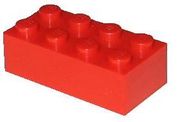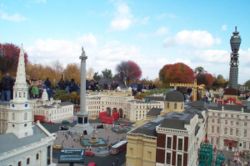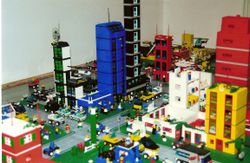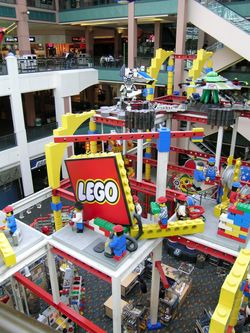Lego
2007 Schools Wikipedia Selection. Related subjects: Games
Lego is a line of toys manufactured by Lego Group, a privately held company based in Denmark. Its flagship product, also commonly referred to as Lego, consists of colorful interlocking plastic bricks and an accompanying array of gears, minifigures (also called minifigs or "Lego People"), and other pieces which can be assembled and connected in myriad combinations. Many interlocking accessories, including cars, planes, trains, buildings, castles, sculptures, ships, spaceships, and even working robots are available for purchase. Lego bricks are noted for their precision and quality of manufacture, resulting in an inexpensive yet uniformly high-quality product.
Early history
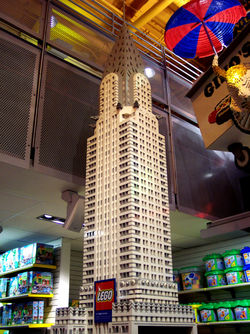
The Lego Group had very humble beginnings in the workshop of Ole Kirk Christiansen, a poor carpenter from Billund, Denmark. Christiansen started creating wooden toys in 1932, however in 1947, he and his son Godtfred Kirk Christiansen obtained samples of interlocking plastic bricks produced by the company Kiddicraft. These "Kiddicraft Self-Locking Building Bricks" were designed and patented in the UK by Hilary Harry Fisher Page, a child psychologist. A few years later, in 1949, Lego began producing similar bricks, calling them "Automatic Binding Bricks." The first Lego bricks, manufactured from cellulose acetate, were developed in the spirit of traditional wooden blocks that could be stacked upon one another; however, these plastic bricks could be "locked" together. They had several round "studs" on top, and a hollow rectangular bottom. The blocks snapped together, but not so tightly that they could not be pulled apart.
The company name Lego was coined by Christiansen from the Danish phrase leg godt, which means "play well".
The use of plastic for toy manufacture was not highly regarded by retailers and consumers of the time. Many of the Lego Group's shipments were returned, following poor sales; it was thought that plastic toys could never replace wooden ones.
By 1954, Christiansen's son, Godtfred, had become the junior managing director of the Lego Group. It was his conversation with an overseas buyer that struck the idea of a toy system. Godtfred saw the immense potential in Lego bricks to become a system for creative play, but the bricks still had some problems from a technical standpoint: their "locking" ability was limited, and they were not very versatile. It was not until 1958 that the modern-day brick design was developed, and it took another five years to find exactly the right material for it.
Design and manufacture
Since their introduction in 1949, Lego pieces of all varieties have been, first and foremost, part of a universal "system". Despite tremendous variation in the design and purpose of individual pieces over the years, each remains compatible in some way with existing pieces. Lego bricks from 1963 still interlock with those made in 2006, and Lego sets for young children are compatible with those made for teenagers.
Bricks, beams, axles, minifigures, and all other elements in the Lego system are manufactured to an exacting degree of tolerance. When snapped together, pieces must have just the right amount of "clutch power"; they must stay together until pulled apart. They cannot be too easy to pull apart, or the resulting constructions would be unstable; they also cannot be too difficult to pull apart, since the disassembly of one creation in order to build another is part of the Lego appeal. In order for pieces to have just the right "clutch power", Lego elements are manufactured within a tolerance of two-thousandths of a millimeter (0.002 mm).
Since 1963, Lego pieces are manufactured from a strong, resilient plastic known as acrylonitrile butadiene styrene, or ABS. Precision-machined, small-capacity moulds are used, and human inspectors check the output of the moulds, to eliminate significant variations in colour or thickness. Worn-out moulds are encased in the foundations of buildings to prevent their falling into competitors' hands. According to the Lego Group, its moulding processes are so accurate that only 18 bricks out of every million fail to meet its stringent standards. It is thanks to this care in manufacturing that the Lego Group has maintained such a high degree of quality over the decades.
Manufacturing of Lego bricks occurs at a number of locations around the world. Moulding is done at one of two plants in Denmark and Switzerland. Brick decorations and packaging is done at plants in Denmark, Switzerland, United States, South Korea and the Czech Republic. Annual production of Lego bricks averages approximately 20 billion (2 × 1010) per year, or about 600 pieces per second.
Lego today
Since it began producing plastic bricks, the Lego Group has released thousands of play sets themed around space, robots, pirates, vikings, medieval castles, dinosaurs, cities, suburbia, holiday locations, wild west, the Arctic, airports, boats, racing cars, trains, Star Wars, Harry Potter, Spider-Man, Batman, SpongeBob SquarePants, Avatar: The Last Airbender and more. As always, new Lego pieces are released frequently along with new sets.
Recently, the Lego line has expanded to encompass accessory motors, gears, lights, sensors, and cameras designed to be used with Lego components. There are even special bricks, like the LEGO RCX that can be programmed with a PC to perform very complicated and useful tasks. These programmable bricks are sold under the name Lego Mindstorms.
There has been a recent update of Lego Mindstorms called Lego Mindstorms NXT. It is more advanced, has a bigger screen on the RCX, and has a new array of sensors. They include touch, sound, light, and a new ultrasonic sensor technology. There is also a Bluetooth compatible hookup that can send messages to your cellphone, and other Bluetooth compatible devices.
There are several competitions which use Lego bricks and the RCX, among other microcontrollers, for robotics. The earliest, and likely the largest, is Botball, a national US middle- and high-school competition stemming from the MIT 6.270 lego robotics tournament. A related competition is FIRST Lego League for elementary and middle schools. The international RoboCup Junior autonomous soccer competition involves extensive use of Lego Mindstorms equipment which is often pushed to its limits.
Lego Group operates several Legoland amusement parks in Europe and California. On July 13, 2005 the control of 70% of the Lego Amusement Parks was sold for $460 million dollars to the Blackstone Group of New York while the remaining 30% is still held by the Lego Group. There are also several Lego Brand retail stores, including at Downtown Disney in both the Disneyland and Walt Disney World Resorts and in the Mall of America in Bloomington, Minnesota. As of year end 2005, there are 25 LEGO Brand Retail stores in the USA, a number of stores in Europe, and a franchised LEGO store in Abu Dhabi.
Fan culture and community
Lego bricks today are used for purposes beyond children's play. The Lego Group itself has developed a form of business consultancy fostering creative thinking, called Lego Serious Play, in which team members build metaphors of their organisational experiences using Lego bricks, and work through imaginary scenarios using the visual device of the Lego constructions and by exploring possibilities in a 'serious' form of 'play'.
A cult following of people who have used Lego pieces to make sculptures, very large mosaics and complex machines has developed. Some sculptures use hundreds of thousands of pieces and weigh tens of kilograms. Large mosaics, fully functional padlocks and pendulum clocks, a harpsichord and an inkjet printer (built by Google co-founder Larry Page while at the University of Michigan) have been constructed from Lego pieces. One such masterpiece solves a Rubik's Cube through the use of Lego motors and cameras, a task that many humans cannot accomplish. Photos of many fan creations like these can be seen at Brickshelf and at MOCpages. A group which calls itself " AFOLs" (for "Adult Fans of Lego") is an important demographic for The Lego Group, which has recently begun reintroducing popular sets from previous years to appeal to this group.
Lego toys have been used in a number of unexpected ways. For example, at The Brick Testament "The Reverend" Brendan Powell Smith has built the Bible in Lego pieces. The site features over 2,000 photographs of Biblical scenes. Legowars, the generic term for a number of wargames (most notably Brikwars) involving Lego bricks enjoys a cult-like popularity. The website theory.org.uk (by academic David Gauntlett) features Lego versions of social theorists. A set of software tools called LDraw or LEGO Digital Designer can be used to model possible Lego creations in 3D. Because of the high degree of uniformity in Lego bricks, they have also been used in fields such as computer vision, in which knowing the exact dimensions and relative positions of objects is useful for creating test data. Another novel application of Lego bricks is the combination of bricks and electronic components to obtain a Lego Electronic Lab Kit.
A growing application for AFOLs is 'cooperative building", the goal being to produce vast displays for Lego shows and fan meets. Moonbase is a Space LEGO building system comprised of individual "modules" built by hundreds of different LEGO builders. These individual modules join together to create large layouts at LEGO conventions and gatherings. Another example of cooperative building is "The Great Ball Contraption" in which enthusiasts are requested to build a machine of carefully specified dimensions that is handed a Lego soccer ball once every second or so. Its job is to do something interesting with the ball and then passes it on to another contraption. By connecting a long chain of such machines together, a vast Rube Goldberg system can be assembled that 'processes' soccer balls from one end of the system to the other having passed each ball through the entire chain of contraptions. Other examples are medieval castles and train layouts.
Lego in art
One hobby among enthusiasts is to make short movies (or re-create popular scenes from famous movies), using Lego bricks. Such movies are called "Lego movies", " Brickfilms", or "cinema Lego". They usually use stop motion animation. For example, the Monty Python and the Holy Grail special edition DVD contained a version of the "Camelot" musical sequence redone with Lego minifigures and accessories.
Lego used to sell a line of sets named "LEGO Studios" (now discontinued), which contains a Lego web cam (repackaged Logitech USB Quickcam Web), software to record video on a computer, black plastic rods which can be used to manipulate minifigures from off-camera and a minifigure resembling Steven Spielberg. Because of the low quality of the camera and software most Brickfilmers don't use it.
Lego bricks have been used to recreate many music videos. Examples include a re-dubbed version of the song " Dragostea Din Tei" by O-Zone, and " Feuer Frei" by Rammstein.
Another notable example is the award-winning music video for the song " Fell in Love with a Girl" by the White Stripes. Director Michel Gondry filmed a live version of the video, digitized the result and then recreated it entirely with Lego bricks.
Artists have also used Lego sets with one of the more notorious examples being Polish artist Zbigniew Libera's " Lego Concentration Camp", a collection of mocked-up concentration camp-themed Lego sets.
The Little Artists have created an entire Modern Art collection in a Lego Gallery. ' Art Craziest Nation' was shown at the Walker Art Gallery in Liverpool, UK.
Several webcomics are illustrated with Lego, notably ' Irregular Webcomic'.
The Lego trademark
The Lego Group's name has become so synonymous with its flagship toy that many use "Legos" or "Lego" (collectively) to refer to the bricks themselves, though the Lego Group considers such use a dilution of their trademark. Lego catalogues in the 1970s and 1980s contained a note that read:
"The word LEGO® is a brand name and is very special to all of us in the LEGO Group Companies. We would sincerely like your help in keeping it special. Please always refer to our bricks as 'LEGO Bricks or Toys' and not 'LEGOS.' By doing so, you will be helping to protect and preserve a brand of which we are very proud and that stands for quality the world over. Thank you! Susan Williams, Consumer Services."
A similar message also appeared to everyone who errantly visited http://www.legos.com/ in the year 2005, however it was removed within the next several months.
"Lego" is officially written in all uppercase letters. The company asserts that to protect its brand name, the word Lego must always be used as an adjective, as in "LEGO set," "LEGO products," "LEGO universe," and so forth. Nevertheless, such corporate admonitions are frequently ignored and the word lego is commonly used not only as a noun to refer to Lego bricks, but also as a generic term referring to any kind of interlocking toy brick.
Trivia
| The number of contiguous configurations for one through eight 2x4 bricks, counting reflections but not rotations |
|
| Bricks | Configurations |
|---|---|
| 1 | 1 |
| 2 | 24 |
| 3 | 1,560 |
| 4 | 119,580 |
| 5 | 10,116,403 |
| 6 | 915,103,766 |
| 7 | 85,747,377,755 |
| 8 | 721,548,684,485,456 |
- The word "Lego" comes from Danish leg godt which translates to "play well". The name could also be interpreted as "I put together" or "I assemble" in Latin, though this would be a somewhat forced application of the general sense "I collect; I gather; I learn"; the word is most used in the derived sense, "I read". The cognate Greek verb "λέγω" also means "gather, pick up", but this can include constructing a stone wall.
- The Lego Group is the largest tire manufacturer in the world, producing over 300 million miniature tires each year.
- Six eight-stud Lego bricks of the same colour can be put together in 915,103,765 ways, and just three bricks of the same colour offer 1,560 combinations. The figure of 102,981,500 is often given for six pieces, but it is incorrect. The number 102,981,504 (four more than that figure) is the number of six-piece towers (of a height of six).
- In Gothenburg there is a building called The Lego House because it looks like Lego.
- "Legot" (or "leegot"), plural form of "lego" (or "leego") is used as a Finnish slang term for human teeth, because of the rectangular shape of the teeth.
